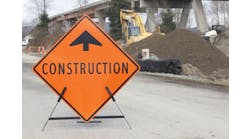The idea didn?t sprout on a cocktail napkin?but you couldn?t fault somebody if they gave in to the temptation. Just about everyone is trying to hand you one of those paper coasters in Las Vegas.
"The Beltway" isn?t your run-of-the-mill lounge act, not when you consider its expansive proportions. The $1.5 billion, 53-mile job forms a ?C? around the valley metropolis, which is one of the fastest growing urban areas in the country.
"It?s something that had been talked about for many, many years," Bobbi Shelton, public information coordinator for the Clark County, Nev., Department of Public Works, told ROADS & BRIDGES. "Prior to 1988 it was something that could?ve been talked about over beers and written on a napkin, but we didn?t have a funding mechanism in place."
These days it?s hard to find a place for all the traffic, and Las Vegas is just a microcosm of the construction activity occuring in the Southwest U.S. The region is crawling with pavers. The state of Nevada is pushing through five other major projects totaling almost $1.4 billion, and Arizona is expecting 20 miles of freeways to open around the Phoenix area. That?s in addition to another $200 million worth of roads expected to open by the end of the year.
The U-haul traffic isn?t expected to slow down anytime soon, either.
"The weather attracts a lot of people out here (to Las Vegas)," said Shelton. "For eight months out of the year temperatures range in the mid-50s to mid-60s. If it was like that year-round we would have 5 million people in this valley."
Taking the speed way
The Las Vegas Beltway, which started in early 1993, is divided into several different segments?each 1 to 2 miles in length. The first goal is to complete 18 projects, or a little over 20 miles, by 2003. The entire job is slated to be complete by 2018.
A majority of the funding comes from a motor vehicle tax and development tax?but the amount can fluctuate annually. Approximately $45 million is collected yearly. Last year an additional $100 million was generated through the state gas tax.
Speed has been injected into this project. Originally, crews were going to build the "ultimate" full freeway configuration section by section.
But as the people started pouring into southern Nevada local officials restructured their thinking, and went with an "accelerated" beltway design and construction plan.
Existing transportation needs in each specific region are dictating the course of action. In areas where traffic volumes are heavy, a full or partial freeway will be constructed. In spots which contain light development and vehicle flow, multi-lane arterials will be built with an ability to expand at a later date. Shelton said as many as 10 lanes in each direction could be constructed in the future.
Once the beltway?s initial alignment is in place the county will upgrade the system, turning it into a more comprehensive freeway facility.
"We tried to plan better than we did 30 years ago," claimed Shelton. "The beltway is designed to minimize congestion on the surface arterials and to get people from point A to point B with minimal stop signs and signals."
Nevada has cleared the way for additional road work across the state. The major jobs include:
- I-15 widening from Las Vegas to the California state line ($100 million);
- U.S. 95 in Northwest Las Vegas ($510 million);
- I-580/U.S. 395 freeway extension to the state capital ($250 million);
- U.S. 93 through Boulder City ($170 million);
- U.S. 395 Carson City bypass ($160 million); and
- U.S. 93 Hoover Dam bypass ($200 million).
The wrangler strangler
For years, Arizona was sitting behind that Dodge Colt on the highway, going 45 in a 55 mph zone. Voters prevented the right legislation to pass through in the ?50s and ?60s, and as a result the transportation system was way behind everybody else. The lack of development put the city of Phoenix in a chokehold?only two freeways circled the urban dwelling.
"We?re way behind," Dan Lance, deputy state engineer for the Arizona Department of Transportation, told ROADS & BRIDGES. "(The voter rejection) was kinda a backlash of not becoming another Los Angeles. We?re way behind the curve and trying to play catch-up."
Straightening up the congestion problem in Phoenix is a top priority. According to Lance, the average decade growth rate in the area is 42%, and as a whole Arizona is one of the leading sun belt states in terms of population growth.
In response to the car jam, 20 miles of new Valley freeways are expected to open in 2001. The entire concrete system is expected to be complete in 2007. A half-cent local tax in Maricopa County and state and federal funding is covering the expense of the following projects:
- Superstition Freeway (U.S. 60) widening between I-10 and Val Vista Drive ($270 million);
- Pima Freeway?Shea Boulevard and Princess Drive ($80 million);
- Pima Freeway?19th Avenue and Scottsdale Road/Scottsdale Road and Princess Drive ($80 million);
- Price Freeway?Guadalupe and Warner Road ($65 million);
- Red Mountain Freeway?Country Club Drive and Gilbert Road ($56 million);
- Red Mountain Freeway?Gilbert Road and Higley Road ($65 million); and
- I-10/Santan Freeway interchange ($26 million).
With the exception of the Superstition Freeway, all jobs will consist of three-lane construction. The Superstition Freeway is more of a reconstruction piece. Contractors will be adding two general purpose lanes, an HOV lane and auxiliary lanes to the existing three-lane road.


